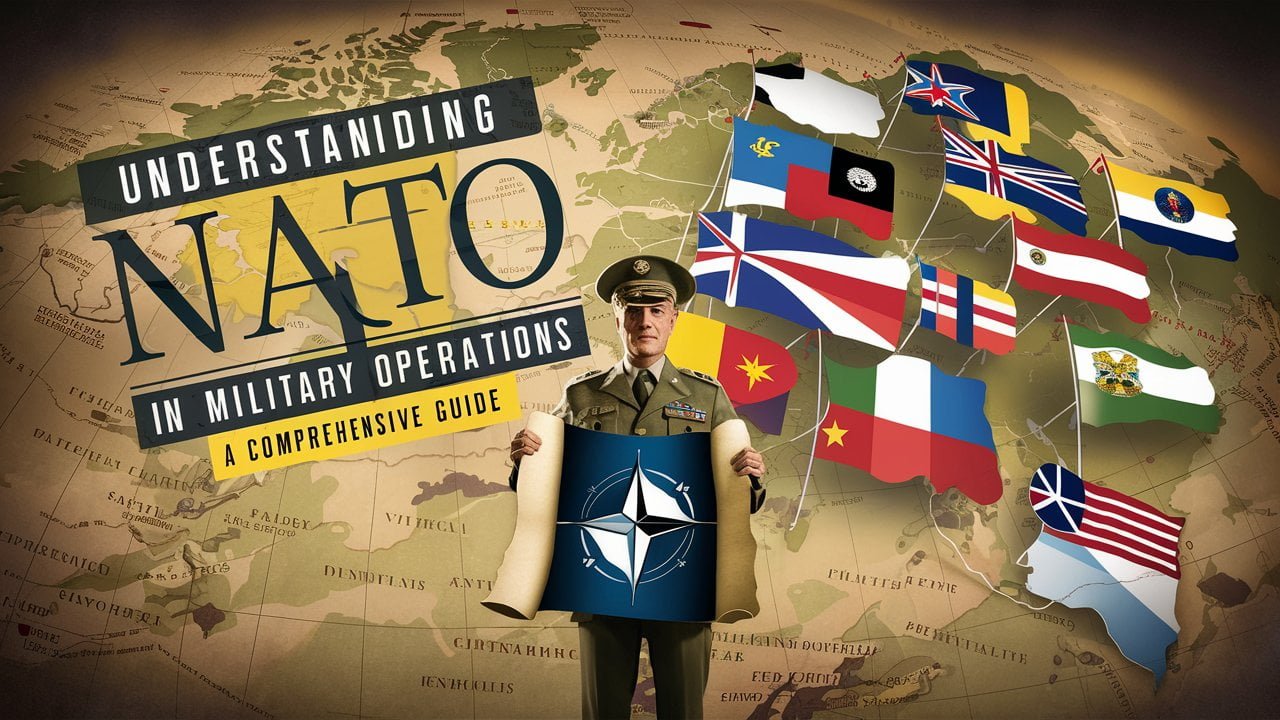In the complex landscape of modern military operations, NATO stands as a cornerstone of international security and defense cooperation. Understanding the intricate workings of NATO is not merely a choice but an imperative for military personnel, defense analysts, security professionals, and government officials alike.
As the world faces evolving security challenges, a nuanced comprehension of NATO’s role becomes paramount to effectively navigate the complexities of global defense strategies.
Delving into this comprehensive guide will illuminate the significance of NATO in military operations with precision and clarity. From its inception to its current functions, this article aims to outline the crucial elements that shape NATO’s operational framework.
By unraveling the organizational structure and decision-making processes within NATO, readers will gain valuable insights into how this alliance strategically operates on the international stage, steering discussions towards informed decision-making in matters of global security.The symbiotic relationship between understanding NATO and enhancing operational capabilities cannot be overstated.
Through a methodical exploration of NATO’s key objectives, contributions from member states, command structures, and crisis response protocols, this guide is designed to equip readers with a holistic understanding of how cohesive collaboration under the NATO umbrella bolsters collective defense measures worldwide.
As we embark on this journey through the intricacies of NATO in military operations, an illuminating narrative awaits those seeking to grasp the true essence of transnational defense alliances.
Overview of NATO in Military Operations.
NATO, the North Atlantic Treaty Organization, was established on April 4, 1949, in response to the growing threat of Soviet expansionism after World War II. The alliance aimed to promote stability and security through a collective defense agreement among its member states.
The founding members included Belgium, Canada, Denmark, France, Iceland, Italy, Luxembourg, the Netherlands, Norway, Portugal, the United Kingdom, and the United States. Since then, NATO has expanded to encompass 30 member countries across North America and Europe.
The primary objective of NATO is to safeguard the security and territorial integrity of its members through collective defense. This cornerstone principle is enshrined in Article 5 of the Washington Treaty that states an attack against one member shall be considered an attack against all members.
Furthermore, NATO endeavors to promote peace and stability by fostering cooperation among allies in various military operations such as crisis management, peacekeeping missions, and humanitarian assistance. Through these endeavors, NATO aims to deter aggression and uphold democratic values.
NATO’s organizational structure is designed to facilitate effective decision-making and operational efficiency. At its core is the North Atlantic Council (NAC), which serves as the alliance’s principal political decision-making body where each member state has an equal vote.
The Military Committee provides military advice and guidance to the NAC while also overseeing strategic military matters. Additionally, Allied Command Operations (ACO) is responsible for planning and executing military operations with Supreme Headquarters Allied Powers Europe (SHAPE) serving as its operational headquarters.
This structured approach ensures that decisions are made collectively with input from all member states while enabling swift responses to emerging security challenges.
NATO Member States and Contributions.
NATO consists of 30 member countries, each playing a crucial role in the alliance’s military operations. The United States, as a founding member and leading contributor, provides significant resources, including troops, equipment, and technological capabilities to NATO missions.
For instance, during the NATO-led mission in Afghanistan, the U.S. played a pivotal role in providing critical air support and logistical assistance to coalition forces. Similarly, the United Kingdom has been an essential ally within NATO, contributing specialized military units to enhance cooperation and coordination during joint exercises and operations.
Germany is another key member state that actively participates in NATO initiatives by offering specialized engineering units and logistical support. In past missions, such as in Kosovo and Afghanistan, Germany’s contributions have been instrumental in ensuring operational success and maintaining stability in conflict-prone regions.
Moreover, France’s extensive military capabilities have bolstered NATO’s strategic deterrence posture, with French forces often engaged in crisis response operations alongside allied nations.
The significance of collaboration among NATO member states cannot be overstated. By pooling together their resources and expertise, these nations create a formidable force capable of addressing security challenges effectively.
Through joint training exercises and military drills, member states enhance interoperability among their armed forces, enabling seamless coordination during complex missions. The shared commitment to collective defense fosters unity within the alliance and sends a clear message of solidarity to potential adversaries, deterring aggression and promoting peace and stability on a global scale.
NATO Command Structure.
Within NATO, the command structure plays a pivotal role in ensuring effective decision-making and operational efficiency. At the highest level sits the Strategic Commanders, who oversee two strategic commands: Allied Command Operations (ACO) and Allied Command Transformation (ACT). ACO, based in Mons, Belgium, is responsible for all operational missions, including planning and execution.
On the other hand, ACT in Norfolk, Virginia, focuses on preparing future capabilities and ensuring NATO forces can adapt to emerging threats.
Allied Command Operations (ACO) exercises authority over operational missions and is led by the Supreme Allied Commander Europe (SACEUR). SACEUR coordinates military forces across different nations to conduct missions such as collective defense or crisis response.
For example, during Operation Unified Protector in 2011 in Libya, SACEUR directed air campaigns to enforce a no-fly zone and protect civilians from threats.
Allied Command Transformation (ACT), headed by the Supreme Allied Commander Transformation (SACT), drives innovation and adaptation within NATO forces. By developing new doctrines, training methods, and technologies, ACT ensures that member states maintain military readiness amid evolving security landscapes.
For instance, ACT’s initiatives have enhanced NATO’s ability to counter hybrid warfare tactics seen in conflicts like Ukraine.
The coordination between these strategic commands enhances operational efficiency by fostering synergy and clear lines of communication throughout NATO’s military operations. Through this structured approach to command roles and responsibilities, NATO can swiftly respond to security challenges worldwide while leveraging the diverse expertise of member states for a unified mission success.
NATO’s Role in Crisis Response.
NATO plays a crucial role in crisis response globally, leveraging its collective military capabilities and political influence to address urgent situations. In times of crises such as natural disasters, humanitarian emergencies, or armed conflicts, NATO swiftly mobilizes resources and personnel to provide assistance and maintain stability.
The Alliance fosters cooperation among member states to enable rapid deployment of forces for crisis management operations. By utilizing a combination of air, land, sea capabilities along with specialized teams trained for crisis response, NATO demonstrates readiness and effectiveness in addressing various types of crises.
During crises, NATO follows established protocols designed to ensure a coordinated and efficient response. The Alliance activates specific contingency plans tailored to the nature of the crisis at hand, outlining roles and responsibilities for member states within the operation.
Decision-making processes are streamlined to allow for quick responses while maintaining adherence to international laws and regulations. Additionally, NATO maintains close communication channels with partner organizations like the United Nations and the European Union to facilitate broader coordination efforts in complex crisis environments.
Examining case studies where NATO intervention was pivotal underscores the organization’s impact on crisis management. For instance, during the Kosovo conflict in the late 1990s, NATO-led Operation Allied Force aimed at stopping ethnic cleansing through airstrikes on Serbian military targets.
This intervention marked a significant moment in NATO’s history wherein military force was used to prevent human rights violations within Europe itself. Similarly, more recent missions like Operation Unified Protector in Libya highlighted NATO’s ability to enforce no-fly zones and protect civilians amidst civil unrest, showcasing the Alliance’s versatility in crisis response scenarios across different regions.
These examples illustrate how NATO’s intervention can have far-reaching implications on global security dynamics by deterring aggression and promoting stability during turbulent times.
Cyber Warfare and NATO.
As the digital landscape continues to evolve, cyber warfare has emerged as a significant threat to global security. NATO recognizes the growing importance of cybersecurity in modern military operations and has taken proactive measures to address this challenge.
Understanding the implications of cyber attacks on critical infrastructure, communication networks, and defense systems is crucial for military personnel, defense analysts, and government officials within NATO member states. By acknowledging cyber warfare as a formidable threat, NATO remains vigilant in enhancing its defenses against potential cyber adversaries.
NATO has implemented various initiatives to combat cyber threats effectively. The Alliance works closely with member states to develop cybersecurity policies, share intelligence on emerging threats, and conduct joint exercises to enhance collective defense capabilities in cyberspace.
Through the NATO Cooperative Cyber Defence Centre of Excellence (CCDCOE) in Estonia, the organization fosters collaboration among experts from member countries to address cybersecurity challenges collectively. NATO’s emphasis on information sharing, capacity building, and technological innovation underscores its commitment to staying ahead of evolving cyber threats.
In the context of modern military operations, cybersecurity plays a pivotal role in safeguarding critical assets and maintaining operational readiness. From protecting sensitive data to securing communication channels during military exercises and missions, ensuring robust cybersecurity measures is paramount for NATO forces.
Recent incidents such as ransomware attacks targeting defense contractors or state-sponsored campaigns aimed at disrupting national security highlight the importance of fortifying cyber defenses within the Alliance.
By continually investing in cutting-edge technologies and fostering a culture of cyber resilience, NATO bolsters its capability to deter and thwart cyber threats that could compromise its strategic interests.
Partnerships and collaborations.
Partnerships and collaborations with non-NATO entities play a crucial role in enhancing global security efforts. By engaging in joint military exercises or missions, NATO can leverage the unique capabilities and expertise of non-NATO partners to address complex security challenges effectively.
These partnerships not only facilitate information sharing but also enable interoperability between different military forces, fostering a more cohesive approach to security operations. For instance, NATO’s collaboration with the European Union (EU) in peacekeeping missions has demonstrated how pooling resources and expertise can lead to more robust and comprehensive responses to security threats.
Analyzing these collaborations reveals their significant impact on strengthening international security efforts. Non-NATO entities bring diverse perspectives, specialized capabilities, and regional knowledge that complement NATO’s operational strategies.
Through joint training exercises and shared intelligence activities, NATO and its non-NATO partners enhance their ability to respond swiftly and effectively to emerging security threats. This exchange of best practices not only improves the overall readiness of forces but also promotes greater coordination in addressing global security challenges.
The successful integration of non-NATO entities into NATO-led missions highlights the mutual benefits derived from collaborative efforts in safeguarding international stability.
Examining case studies showcasing successful collaborations between NATO and non-NATO entities underscores the tangible outcomes of such strategic partnerships. For example, the cooperation between NATO and partner countries like Sweden and Finland has enhanced naval patrols in the Baltic Sea region, ensuring maritime security against potential threats.
Additionally, joint counterterrorism operations conducted by NATO alongside nations like Australia have proven instrumental in combating transnational terrorist networks.
These case studies serve as compelling examples of how shared commitments toward common goals can yield effective outcomes in bolstering global security architecture through inclusive partnerships between NATO and external stakeholders alike.
Importance of Continued Understanding and Collaboration with NATO.
Understanding NATO’s role in military operations is paramount for enhancing global security measures. By comprehensively grasping NATO’s organizational structure, key objectives, member contributions, and crisis response capabilities, military personnel, defense analysts, security professionals, and government officials can make informed decisions that impact international stability.
Through ongoing collaboration with NATO and its member states, a harmonized approach to addressing security challenges worldwide can be achieved.
Continued cooperation with NATO presents various benefits for maintaining stability. The collective efforts of member states under the NATO umbrella allow for the pooling of resources, sharing of intelligence, and efficient coordination in crisis situations.
Moreover, partnerships with non-NATO entities leverage diverse expertise and resources to bolster security initiatives globally. By fostering a deep understanding of NATO’s mechanisms and actively engaging in collaborative endeavors, stakeholders can contribute significantly to upholding peace and security on an international scale.




